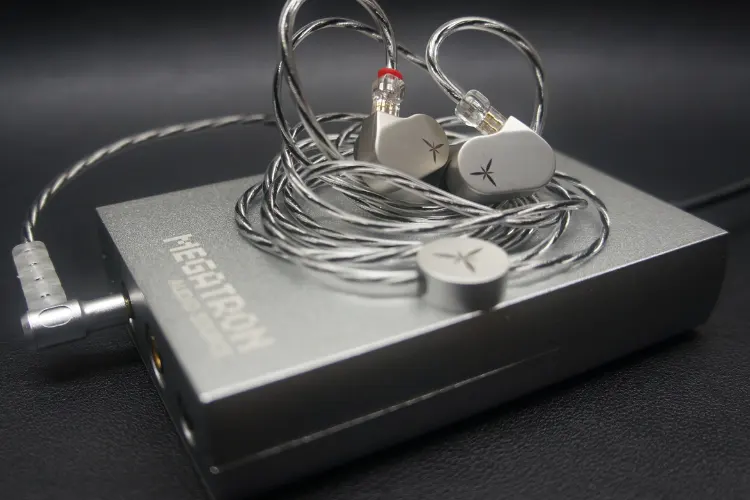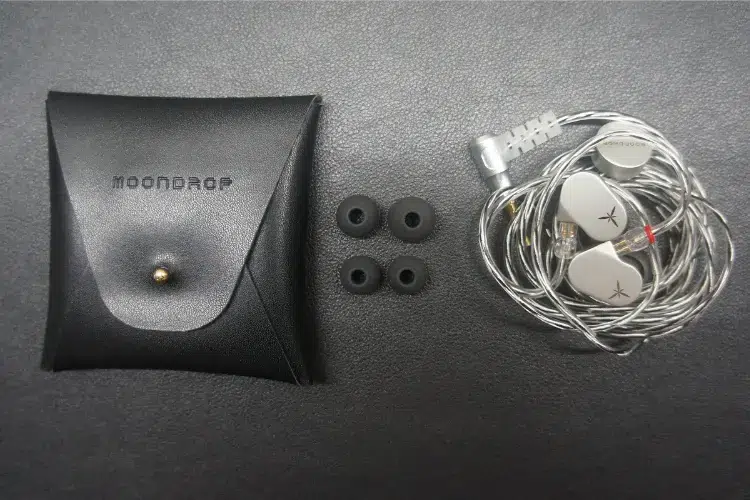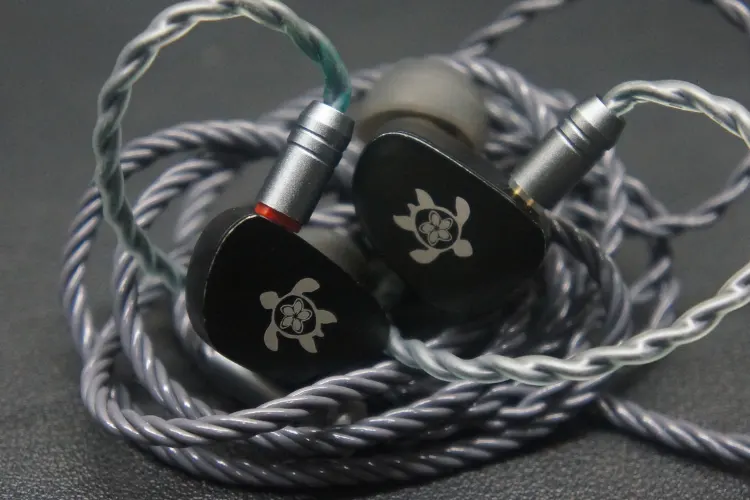In this feature, we review the MOONDROP LAN, which is an entry-level single 10mm dual-cavity dynamic driver in-ear monitor. It is priced at $39.99
Disclaimer: This sample was sent to us in exchange for our honest opinion. Headfonics is an independent website with no affiliate links or status. We thank MOONDROP and Shenzhen Audio for their support.
To read more about MOONDROP products we have previously featured on Headfonics, click here.
Note, that this article follows our latest scoring guidelines which you can read here.
MOONDROP, the company with a reputation for disrupting every price segment it enters with products ranging from headphones such as the Wraith and their higher-end Variations IEM, is back with a new budget offering called LAN.
Despite not being explicitly stated by MOONDROP, it’s difficult to ignore the similarities between the LAN and their other popular budget release, the MOONDROP CHU.
Entering the sub-$50 price range promising a familiar tuning target curve, as well as detachable cable and their legacy build quality, let’s see if MOONDROP has what it takes to make a splash once again.
Tech Highlights
The MOONDROP LAN makes use of an exciting new single DD plated in beryllium, which hopefully contributes to excellent detail representation and natural and neutral-sounding timber.
Despite being a somewhat common feature within the price range, it is important to highlight that it comes with a detachable cable, a welcome departure from the attached cable seen in the MOONDROP CHU, an IEM some may consider as the LAN’s spiritual predecessor.
Depending on this listener, the use of MOONDROP’s VSDF tuning curve could be a pro or a con, but being able to provide a good introduction to MOONDROP’s in-house tuning philosophy within this price range is rather exceptional.
Design
The MOONDROP LAN has a simple yet sharp finish because of its stainless-steel construction and its MIM powder metallurgy process. This gives a pleasing finish that feels matte but still reflects light at certain angles.
The only pieces of explicit branding on the IEMs themselves are the decorative three-petal flower logos towards the bottom of each faceplate.
The contrast of the silver metallic finish and the subtle black flower gives it a minimalist look that does not stand out in daily usage but also gives it some character. The shells also have two pressure vents on each side, which aid in reducing driver flex and contribute to the comfort of using the IEMs.
Comfort and Isolation
Despite each LAN shell having a nice heft due to its stainless-steel build, they feel lightweight once in use.
They have a compact build and ergonomic shape that conforms well and fits well in the ear. I occasionally forget that they’re in my ear because of how well they fit.
The three included pairs of silicone tips provide a nice seal once you find the size that’s right for you. They provide a decent degree of isolation, especially for a vented IEM, however, you would still be able to hear loud co-workers even with music playing.
It is important to note that the more affordable MOONDROP CHUs come with the more expensive Spring Tips, which would have been nice to have at this higher price point.
Stock Cable
Unlike its older CHU, the LAN comes with a detachable 2-pin 0.78mm cable that terminates to an L-shaped gold-plated 3.5mm SE plug. The cable itself is a braid of silver and black wires that are encased in a thin plastic sleeve. The contrast of the black and silver wires goes well with the colorway of the IEM shells.
The cable itself has very minimal microphonics when it rubs against your shirt as you move around. The cable also has a silver metal splitter with the same finish as the IEMs themselves. The splitter shows the MOONDROP logo on one side, and the LAN flower logo on the other.
Packaging & Accessories
The MOONDROP LAN comes in a large decorative white box with a large drawing of an anime waifu covering the majority of the sleeve’s front. The rear of the outer sleeve shows an exploded view of the IEM as well as the target curve MOONDROP tuning.
The box itself has quite large and has a nice embossed textured finish. Opening the box immediately shows the IEMs in an indented piece of foam, with the soft high-quality leather case right under it. The case itself would not do a great job protecting the IEMs from impact, however, it is constructed from very soft and satisfying leather.
Opening the case shows the included removable cable, and the 3 pairs of silicone tips. Once again, the inclusion of regular silicon tips instead of the spring tips found in the MOONDROP CHU seems like an oversight, especially at this price range.
Removing the foam shows all the product documentation and a nice postcard with the MOONDROP LAN waifu.
Sound Impressions
Bass
In line with the VSDF target, the LAN’s bass is not boosted or elevated by any means. It presents a good punch and impact in Hip Hop and Pop tracks that intentionally put the bass at the forefront, but I can see this tuning being considered bass-lacking for a large majority of people who are into a more “fun” sounding set of IEMs.
Luckily, this bass response ensures that none of it bleeds into the mids or interferes with vocals or instruments in the lower mid-range. The LAN can adequately represent the punch of Bass hits, it just does so with a quantity that most may find lacking.
Mids
The mids of the LAN are flat, clear, and extremely natural sounding. The timbre, especially in the mids, is one of its biggest strengths. Guitar strums and lower piano keys sound natural and are presented with good tonality.
The vocal and instrument separation in the mid-range is exceptional as well given the price point. The music never sounds compressed or veiled, and each individual instrument easily stands out from one another.
They can adequately represent even the slightest nuances or tone changes in vocals, especially female vocals on the upper register.
Treble
The treble performance of the LAN is excellent, with a crisp presentation that extends well into the high end. The level of detail in the high-end makes even different kinds of cymbals seem easily differentiable.
Despite this level of detail, the treble isn’t harsh or sibilant. I had no complaints when using it to listen to tracks that I intentionally use to check for sibilance. This kind of treble presentation adds a lot of energy to different music, making them seem more dynamic.
It is worth mentioning that despite the highs standing out, they do not bleed into the upper mids. The LAN can properly isolate vocals and instruments even in tracks with high-pitched female vocals and multiple cymbals and hi-hats.
Staging
The imaging performance is precise despite its relatively narrow soundstage. In addition to its excellent isolation making each instrument easily identifiable, it is also able to present them in a way that clearly places each instrument where it needs to be. None of the instruments or vocals feel compressed or mixed with one another.
The LAN has a very intimate presentation, that contributes to the excellent detail retrieval given the unit’s good imaging performance.
Synergy
Efficiency
The MOONDROP LAN is relatively easy to drive and does not require an amplifier to reach reasonable listening volumes.
It has a low impedance of 32Ω and a high sensitivity of 120 dB/Vrms, meaning that it can be powered by most sources, such as smartphones, laptops, or portable players. Despite this, the LAN does have improved dynamics when paired with a dongle DAC such as the 7hz SEVENHERTZ 71.
Pairings
Considering the LAN’s lacking bass response alongside its efficient and sensitive power requirements, I found that it paired best with the 7hz SEVENHERTZ 71 DAC AMP over something like the VE Megatron, (high noise floor).
Not only did the 71 improve the dynamics overall, but it also added a slight bass bump that made listening more enjoyable.
Select Comparison
Tripowin Olina SE
Technical
Both the Tripowin Olina SE and the MOONDROP LAN make use of a single 10mm dynamic driver. However, the one used in the Olina is constructed out of Carbon Nanotubes (CNT) whilst the one used in the LAN is coated in Beryllium.
Design
Both IEMs are similarly sized, with the LAN having a more contouring shape as opposed to the capsule-like shape of the Olina SE.
Whilst the shell of the LAN is made of MIM stainless steel with a matte feeling silver finish, the Olina SE’s shell is made from aluminum that has been anodized to have a sharp black finish, with a stylized silver turtle on each of the monitors.
The Olina feels denser with a shape that is less ergonomic. For me, having it in your ears is less comfortable compared to the LAN. Both the Olina and the LAN make use of 2-pin 0.78mm connectors, and both IEMs come with a detachable 3.5mm cable.
Performance
Both the LAN and the Olina SE have neutral and natural-sounding tonalities. However, their tuning styles still have specific differences.
Both IEMs present bass in a natural-sounding manner that does not feel artificially bloated, however, the Olina has more bass quantity, giving bass hits a more impactful feeling. The quality and presentation between both IEMs are similar, but the tuning of the Olina makes the bass stand out more when compared to the LAN.
Despite this, I would consider neither of the IEMs to be bass heavy. They do a good job preventing the bass from bleeding into the mid-region, giving them a clean-sounding presentation.
The mids are presented in a neutral manner as well, however, the Olina SE has a slightly warmer presentation of the mids, being able to highlight lower-pitched male vocals and rhythmic bass lines in funk music.
The vocals feel like they have more body when playing through the Olina. In comparison, the LAN has an airier presentation that accentuates higher-pitched female vocals and string instruments such as acoustic guitars and piano keys.
The treble on the Olina is less detailed, less prominent, and feels flat in comparison. The Olina presents all kinds of cymbals in a similar manner, whilst the LAN makes them easily differentiable. Higher-pitched synths in pop music appear significantly more nuanced when played through the LAN instead of the Olina.
It is important to note that although quite minimal, the LAN exhibits more sibilance than the Olina. However, Olina’s detail retrieval is comparatively lacking.
The LAN’s superior instrument isolation contributes to this better sense of detail. Despite not being particularly bad, Olina’s presentation of different instruments is less definite and vaguer.
Our Verdict
Even amongst the recent explosion of budget ChiFi IEMs within the price range, the MOONDROP LAN stands out with its excellent detail retrieval, treble performance, and robust build quality.
The inclusion of a detachable cable is an upgrade from the CHU version that precedes it, however, the omission of MOONDROP’s legendary Spring tips is baffling.
For new audiophiles who have the itch to upgrade from sub-20-dollar IEMs, this IEM has a lot to love. It presents an exceptional level of detail retrieval for the price, whilst also providing a good introduction to MOONDROP’s tuning philosophy. For its $40 asking price, it is worth considering.
MOONDROP LAN Specifications
- Driver Type: 10mm dual-cavity high-performance dynamic driver
- Diaphragm: Beryllium-plated dome composite diaphragm
- Plug: 3.5mm single-ended 0.78mm-2pin
- Frequency Response: 15Hz -37kHz
- Impedance: 32 0hm±15% (@1kHz)
- Sensitivity: 120 dB/Vrms(@1kHz)











